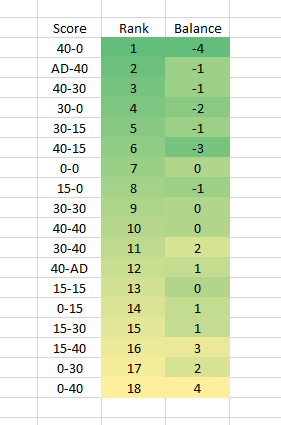How to read a Tennis players mind
Psychology everywhere
Psychology isn’t trapped in your head when you trade on Betfair – it’s sprinting around the baseline with the players. Tennis markets swing on human quirks: loss aversion makes backers cling to fading favourites, while hero worship inflates odds the moment a big-name cracks an ace. Momentum bias? One hot service game and prices spiral as if the match is over.
For traders that’s gold dust. Every emotional tremor – a double fault, a disputed call, a roar from the home crowd – jolts the odds faster than raw stats can. Spot the wobble, gauge the mood, and you’ll know when a break of serve or a set swing is brewing before the model does.
These biases don’t just skew bettors; they seep onto the court itself. Under pressure, even pros tighten up exactly as the market’s punters do, reinforcing each price shift. Read the shared psychology, time your entries, and you’re suddenly trading the players’ nerves as much as their strokes – and that’s where the real edge lies.
Psychology in Tennis
Chasing an edge on Betfair means more than having a decent strategy; you’ve got to out-think the point-by-point drama. Tennis turns on split-second pressure swings, so I drilled into those critical moments to see how they really shape the market.
Take the very first rally: does a player treat 15-0 with the same nerves as 0-15? And what happens when the scoreboard flashes “break point”? Spoiler: the shift isn’t linear, and the stats alone won’t tell you why. Some players tighten, others swing freer, and the market’s mood mirrors every twitch.
Decode those reactions and you’re suddenly trading the psychology, not just the score. Anticipate how a server handles break point or how a returner responds to 0-30, and you can slip into positions before the odds catch up. In short, read the pressure, ride the pulse, and stay a rally ahead of everyone else.
Thinking through the problem
I start each data analysis by blanking out any predictions—the quickest way to contaminate a study is to guess the ending. Instead, I map the data and decide what I’m really hunting for.
Logic says a pro treats 40-30 just like 40-15, maybe even swinging harder when the game is on the line. But do they?
Ask yourself: are all points equal, or do some spike the pressure?
Rather than crunch expected-price models (easy enough), I wanted a metric that lays bare a player’s mindset. Serve speed nailed it. A confident server adds a few extra mph; a jittery one throttles back for control. Track that pulse point by point and the psychology jumps off the chart.
Thought experiment
I zoomed in on the extremes—40-0 and 0-40—to see how pressure really bites. Elite servers normally pocket 78–84 % of points, so even triple break point isn’t fatal. But force them onto a second serve at 0-40 and that win rate can plunge by 20–30 %. Flip the script: at 40-0 they often throttle back, choosing accuracy over pace to seal the game. Those split-second adjustments expose a player’s risk maths—and hand switched-on traders the moments to strike.
The results
My serve-speed analysis threw up a twist I didn’t see coming, and the chart below lays it bare. At triple break point (0-40) the pros don’t reach for the nuclear option; they throttle back. Track every scoreline, as I’ve plotted in the image, and the pattern is unmistakable: the further ahead a player sits, the harder they hit; the deeper the hole, the gentler the gun. Fastest average? 40-0. Slowest? 0-40.
Why this upside-down logic? A server under siege is desperate simply to land the ball, but the softer delivery gifts the returner time—usually sealing their fate. It feels counter-intuitive; you’d expect a “nothing-to-lose” cannonball to be the get-out card. Yet the data say otherwise, and the graphic makes the drop-off painfully clear.
The takeaway for us traders is priceless. Even world-class athletes shrink from loss just as we do: pressure trims the mph, the nerves leak into the market, and the moment to strike flashes up on Betfair before the casual punter has blinked. In short, read the lines on that image, trust the psychology, and step in while the serve still hangs in the air.

